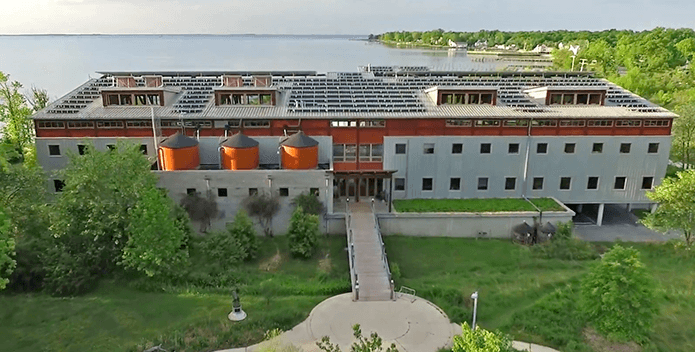- Overall, the center uses 50 percent less energy than a typical office building of equivalent size, number of employees, and plug loads, for an annual savings of approximately $50,000.
- The 111 kW solar system produces approximately 135 MWh of electricity each year, resulting in a savings of roughly $16,000.

A 111 kW solar array on the roof of CBF's Philip Merrill Environmental Center produces roughly 35 percent of the building's energy needs--or 135 MWh of electricity annually--resulting in a savings of approximately $16,000.
DroneVideo Now
- The center's total four year average water savings equal 1.35 million gallons not processed by sewage treatment plants, thus saving nearly $7,000.
- Heating and cooling systems don't run during about 33 percent of the year because the center uses the sun's free heat and open windows for natural breezes.
- Solar hot water systems provide annual savings of $500.
- Water consumption is 80 percent less than a conventional building, and that includes the center's onsite showers and laundry facilities. Average daily water use is 150 gallons—approximately 40% of which is rainwater. Without water-saving technology, normal daily use would be about 1,000 gallons.
- Composting toilets save a great deal of water and sewage rates compared to an office of 100 people with conventional toilets. At $25,000 to install, composting toilets have a simple payback of less than ten years, and have many advantages that go beyond mere dollars and cents.
- Smart parking design reduces harmful runoff from surfaces by placing parking under the building and using gravel surfacing for parking outside the building. Gravel slows runoff and allows particulates to drop off. Also, its light color reduces heat retention in the summer.
- By disturbing the land as little as possible during construction, the center has restored and incorporated native habitat for wetlands and wildlife on surrounding land, and teamed up with the local community to form the local land trust that protects the entire property.
- The center has less impermeable surface now than when CBF bought the property.
- CBF cut down only four trees to build the facility, and has planted hundreds of trees, shrubs, and new grasses.
•The Savings of Building Green
The Savings of Building Green
The Merrill Center is an ENERGY STAR "Top Performance" building with a rating of 98 for energy efficiency. This rating is 50 percent better than the national average for similar office buildings. Based on the center's average energy use, this equates to an annual savings of almost $50,000.


